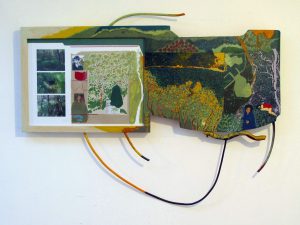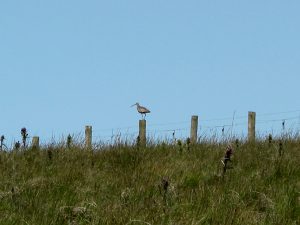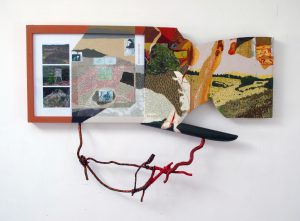My friend Judy Tucker is currently writing a book chapter about walking in contemporary art practices and thinking about the links between these two activities in ways that go beyond the usual, obvious, connections (Richard Long et alia).
In that context, she asked me to note down a few lines about my current work, my move with, and beyond, ideas of deep mapping, and about the way I ‘walk with’ and collaborate. (We have known each other a long time, worked together in teaching contexts, and are joint co-ordinators for LAND2 with Mary Modeen). What follows is a slightly extended version of my response to her questions, which is I think relevant in the context of this blog because of the growing importance of walking as a relationship to the multiple layers of our environments.
I began by saying that I’m puzzled, and challenged, by the way the relationship between walking and art practice has been fragmented by very literal (and consequently divisive) notions of ‘process’ in relation to ‘product’. This is an aspect of my growing impatience with the way in which so much discourse on art still tends to work against a proper sense of its wider relationality. Because of that lack of a fuller sense of connectivity, it’s much harder to think about the roles of a poetics of walking in the work of a painter like Eamon Colman and the work of of Hamish Fulton than it should be. Since 1972 all Fulton’s work has, like Colman’s, been based on the experience of walks. But while Colman translates his experience of walks into the highly condensed form of paintings, Fulton translates his into a wide variety of media. This process of translating what is experienced through walking is, however, central to both men’s work and also an important aspect of my own deep mapping work. (Much could be said about that act of translation and it’s possibilities and difficulties, but that’s nay concern here). Anyway, Colman is one of the painters I’m looking at carefully now as I try to convert my experience of deep mapping into a new way of working.
Notitia 3: Birch Moss 2017
So, for about a year now I’ve been trying to make small, lyrical ‘micro-mappings’ that, in a compound and condensed form, evoke a rich sense of place, drawing on Edward S. Casey. (Casey identifies our experience of place as, notwithstanding its normally settled appearance, “an essay in experimental living within a changing culture”). Specific places, many in the English/Scottish Border country I’ve been exploring for almost twenty years now, continue to play a key role in this. To Casey’s understanding of place, I’d add Doreen Massey’s insistence on what she calls: ‘a global sense of place’, all its connectivities out into the wider environment. So, part of walking in a place is about noticing, even conversing silently with, the traces of its wider life. The washed-out chocolate bar wrapper that is the slowly fading ghost of the multiple journeys of organic and inorganic substances (cocoa beans, pulped wood, metal foil) through the innumerable processes that feed the global consumer market. Or the curlew as it starts its migration from the upland Borders moors towards its wintering ground, perhaps even on some part of the Severn estuary that I’ll visit with my wife on one of our weekend trips out of Bristol to walk. Walking, conversation (internal or external) and noticing (notitia is the series title of the body of constructions I’ve been working on) are perhaps inseparable, at least unless you’re a Zen practitioner on a silent walking meditation.
Although, for a variety of reasons, I can’t walk as much or as far as I would like nowadays, I continue to ‘walk with’ people, for reasons that are related to what academics call fieldwork or research. (The difference lies in the fact that my reasons for ‘walking with’ are only partly instrumental, to do with ‘gathering facts’ or ‘getting at sense of the place’. Other, less academic reasons, are sheer curiosity and the simple pleasure of walking with a congenial companion.
A while back the performer and artist Marega Palser (who recently contributed an invited post to this blog) invited me to walk with her in Newport. This invitation grew out of her interest in the possibilities of deep mapping, but when we walked together that became absorbed into her evident love of the town, its particularities and idiosyncrasies. In a sense that walk was undertaken simply in the spirit of seeing walking conversations in and about places as the most fundamental form of creative collaboration. As such, it was a truly memorable experience. But, of course, I can also ‘walk with’ people who are not present in any literal sense. In my case, when I’m walking in the Borders it’s often with favourite singers of old ballads, writers of various kinds, the spirit of the old farmer whose pronunciation of my name sounded like ‘iron’, with cultural geographers, and so on.
When I was working with the poet, artist and geo-mythologist Erin Kavanagh on the collaborative project that became The Crow Road, is wasn’t simply a collaboration with her. It was also very much about walking back in conversation with my childhood self into memories of a childhood landscape and then re-viewing it with Erin’s poem in mind. (Although, obviously, she and I also exchanged material of various sorts as well). These days, I’m starting to work as much out of ‘walking with and round’ old and familiar landscapes in memory as I do from fieldwork.
Notitia 7: Tamshiel Rig 2018
The current Notitia series, each a hybrid form made up of collage and painted construction, draws heavily on walking as conversation, along with photographic documentation, in the English/Scottish Borders. That’s the underlying ground work. But they also play with notions of conceptual framing (echoed in the literal use of a frame incorporated into each work), and develop an earlier, quite shameless, borrowing from Polynesian stick charts. (Which I love as a tactile form of mapping). What I am aiming for, perhaps still rather uncertainly at present, is to make a richly polyvocal object/image that can interweave visual, tactile and conceptual evocations of material in and around a specific landscape, in the tradition of deep mapping, but while still finding the necessary degree of coherence to ‘work’ as a small construction hung on a wall.


